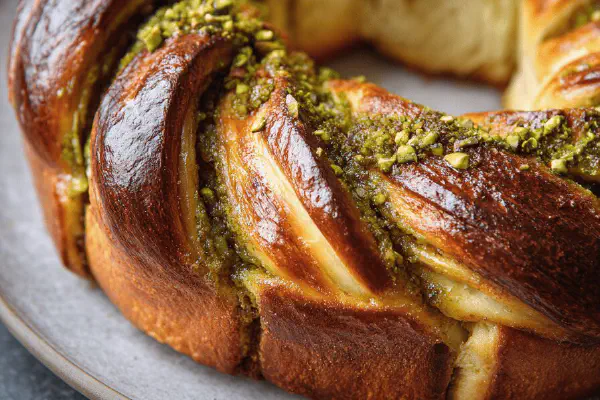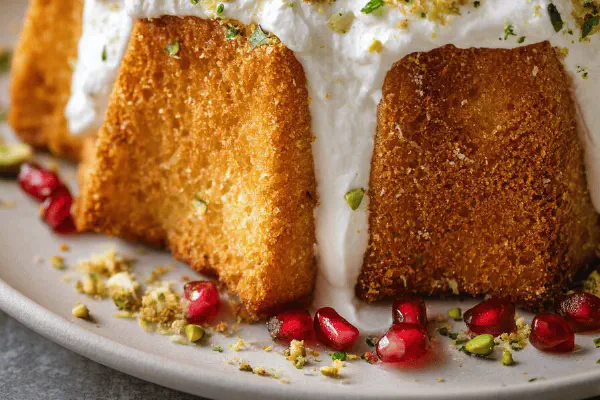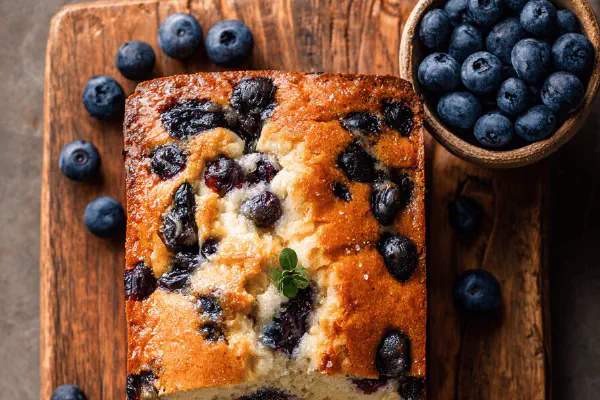Pistachio Brioche Twist

By Emma
Certified Culinary Professional
Ingredients
Brioche Dough
- 315 g (2 1/3 cups) unbleached all-purpose flour
- 22 ml (1 1/2 tbsp) granulated sugar
- 7 ml (1 1/2 tsp) instant yeast
- 4 ml (3/4 tsp) fine sea salt
- 240 ml (1 cup) whole milk, lukewarm
- 60 g unsalted butter, browned and cooled
- 1 large egg
Pistachio Filling
- 80 g (3/4 cup) shelled unsalted pistachios, roughly chopped
- 40 g (3 tbsp) honey
- 20 ml (1 1/2 tbsp) all-purpose flour
- 3 ml (3/4 tsp) ground cardamom
- 1 ml (1/4 tsp) salt
- 1 egg, room temperature
About the ingredients
Method
Pistachio Filling
- 1. In food processor pulse pistachios until coarse but not powdery. Transfer to bowl.
- 2. Add honey, flour, cardamom, salt, and egg. Stir until thick and clumpy. Texture should spreadable but with nuts intact. Set aside.
Brioche Dough
- 3. Combine flour, sugar, yeast, salt dry in mixing bowl. Yes, salt away from yeast in your head for healthy rise. Toss together.
- 4. Warm milk just till finger test warm; not hot or kills yeast. Add to dry mix with browned butter (warm or cool, butter browned adds deep nuttiness). Throw egg in last, stir just to combine—a shaggy mass forms.
- 5. Knead on floured surface or in stand mixer with dough hook 3-4 minutes. You want smooth, slightly tacky dough—not sticky, but yielding to touch. Kneading develops gluten; essential for brioche lightness yet sturdy for shaping.
- 6. Lightly oil bowl, place dough, cover with plastic wrap or damp towel. Warm, humid spot Q-tip test. If your kitchen is dry, preheat oven to 30°C (85°F) then turn off, place dough inside. Let rise 1 hour until roughly doubled, gentle puffy feel when pressed.
Assembly
- 7. Flour board lightly. Roll dough into approx 40 x 22 cm (16 x 8.5 in) rectangle. Not too thin; thickness holds filling better.
- 8. Spread pistachio filling over dough, leaving 4 cm (1 1/2 in) bare strip on one short side to seal.
- 9. Roll dough starting from opposite fill border, like jelly roll. Seal edges by pinching strip edge firmly to roll.
- 10. Place roll seam side down in well buttered loaf pan 24 x 11 cm (9 1/2 x 4 1/2 in). The size matters or dough may spread too thin or mound too high.
- 11. Cover loosely, let proof 20 minutes till dough puffs and almost fills pan. Overproofing? Dough may collapse or flatten, so watch closely after initial rise.
- 12. Preheat oven to 185°C (365°F); rack middle slot.
- 13. Brush dough surface gently with water or egg wash for shine and crust variation. I like water for subtle matte crust; egg wash gives sparkle but can obscure nuts.
- 14. Bake 38-42 minutes. Oven smells change; crust deepens to golden-lustrous brown. Tap on bottom, hollow sound signals done. Tent foil if browning too fast.
- 15. Remove from pan immediately to wire rack. Leaves crust crisp rather than soggy from steam trapped inside pan.
- 16. Cool completely before slicing; cutting warm brioche crushes structure and makes gummy bread.
Notes
- If no pistachios, toasted, chopped almonds or walnuts work. Brown butter important here—adds complexity you can’t replace with regular melted butter.
- If kitchen cold, extend initial rise by 15-20 minutes; dough needs warmth otherwise yeast stalls.
- Dough can be refrigerated overnight after first rise. Bring back to room temp before shaping to activate yeast again.
- If dough feels sticky during shaping, sprinkle flour sparingly; too much flour sucks moisture making crumb dry.
- Browning butter: melt slowly on medium, watch for nutty aroma; don't burn. Cool before adding to yeast or curdling risk.
- Cardamom adds aromatic warmth, but cinnamon or orange zest are fine substitutes. Avoid overpowering spices.
- Honey sweetens filling and keeps paste moist. Maple syrup or agave syrup substitute but flavor alters.
- Use fresh pistachios; stale nuts dull flavor and texture impact.
Cooking tips
Chef's notes
- 💡 Brown butter slowly on medium heat. Watch closely; nutty aroma shifts fast. Burn? Bitter. Cool fully before mixing yeast or curdling risk. Color deep golden, almost hazelnut, is sweet spot. Adds nuttiness depth missing in melted butter. Don't skip.
- 💡 Knead dough until tacky but not sticky. Windowpane test optional but useful. Over-kneading crushes air; under kneading sticky mess. Dough should yield with pressure but hold shape. Tacky feels more forgiving, helps shaping without flour overdose. Flour dust sparingly; too much dries crumb.
- 💡 Rise times vary with kitchen temp and humidity. Too cold? Use oven set at 30°C, then turn off to create warm moist atmosphere. Covered with damp towel or plastic wrap to trap steam. Watch dough puff slowly; doubled volume not always exact. Press test helps; gentle dent returns slowly indicates ready for next step.
- 💡 Spread pistachio filling evenly but leave 4 cm strip bare for sealing roll edges. Coarse chopped nuts create textural contrast, keeping bites interesting. Filling thick and slightly clumpy, not runny. Honey keeps moist but can swap for maple or agave; flavor alters. Cardamom optional; if skipped, vanilla extract can replace but less floral.
- 💡 Bake at 185°C; watch crust color and smell changes. Golden-lustrous brown means done; tap bottom for hollow sound. If browns too fast, tent foil to avoid burnt edges. Freshly baked crust crisp, but steam inside pan soggy if kept too long. Remove immediately, cool on wire rack. Slice only fully cool; warm crumb collapses, becomes gummy. Store airtight, reheating in toaster or low oven restores texture.
Common questions
How to tell when dough has risen enough?
Look for puffiness, not always double size. Press gently; dent should spring back slowly. Too fast or slow means timing off. Warm humid spot helps. Oven at 30°C great hack if kitchen cold.
Can I substitute pistachios?
Yes. Toasted almonds or walnuts work but flavor changes. Coarse chop keeps texture. Avoid salted nuts unless soaked and dried well to remove salt. Salt ruins filling balance otherwise.
What if dough feels sticky during shaping?
Sprinkle flour lightly but sparingly. Too much flour sucks moisture, dries crumb. Sticky means under-kneaded or too warm. Chill dough briefly if needed. Avoid overcorrecting with flour.
How to store finished bread?
Wrap airtight; keeps moist for several days. Refrigeration dries crumb faster. Can freeze slices too. Reheat gently in toaster or low oven restores softness. Avoid microwave; makes rubbery.



